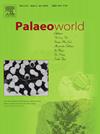Upper Cretaceous (Cenomanian–lower Campanian) nannofossils and sequence stratigraphy of southwestern Crimea
IF 1.7
3区 地球科学
Q2 PALEONTOLOGY
引用次数: 0
Abstract
The first high-resolution study of the Cenomanian to lower Campanian calcareous nannofossils of two most continuous but poor in macrofossils sections of southwestern Crimea allowed the detailed division of these successions on the basis of standard nannofossil zonations and the correlation with Tethyan and Boreal Upper Cretaceous. After initial Cenomanian sea-level fall, nannofossil assemblages increase their abundance and taxonomic diversity toward the end of Cenomanian. The most of the Cenomanian bioevents are recognised in the sedimentary record. The Cenomanian/Turonian transition is the most stratigraphically intricate interval in the Late Cretaceous Crimean basin. The lowest occurrences (LOs) of Cylindralithus biarcus, Quadrum intermedium, Eprolithus octopetalus, Ahmuellerella octoradiata are identified in the upper Cenomanian. The highest occurrences (HOs) of some stratigraphically important for this time span taxa like Corollithion kennedyi, Cretarhabdus striatus and Axopodorhabdus albianus are found significantly above the levels defined as relevant subzonal boundaries (UC3e, UC4b and UC5b, respectively). The TOC-rich sediments corresponding to Bonarelli Level (OAE2) is intercalated in the upper part of the upper Cenomanian limestones (undivided interval of UC5c-UC6a subzone/zone). Helenea chiastia is scarce in the studied succession and its HO cannot be used for definition of zonal boundary (UC6) and the base of Turonian. The most reliable bioevent closest to the Cenomanian/Turonian boundary in this basin is the LO of Eprolithus moratus (base of UC6b subzone). The middle Turonian to lower Campanian nannofossil assemblages display the succession of the main bioevents similar to those in Tethyan basin, but show earlier LOs of Micula and Reinhardtites in the middle Turonian.
Nannofossil biostratigraphy revealed the stratigraphic range of hiatuses in this sedimentary record. Being combined with the levels of the major facies changes, these levels enabled the recognition of five Cenomanian and four Turonian sequence boundaries consistent with the sequence stratigraphy established for Europe. Two sharp erosional surfaces occurred in the upper part of the studied succession correspond to the Coniacian KCo1 and Santonian KSa2 sequences.
克里米亚西南部上白垩统(塞诺曼—下坎帕纪)纳米化石与层序地层学
对克里米亚西南部两个最连续但较差的宏观化石剖面的Cenomanian - lower Campanian钙质纳米化石进行了首次高分辨率研究,在标准纳米化石分带的基础上,并与Tethyan和Boreal上白垩统进行了对比,从而对这些序列进行了详细划分。在塞诺曼期海平面下降后,纳米化石组合的丰度和分类多样性在塞诺曼期末期增加。大多数塞诺曼尼亚生物事件在沉积记录中得到确认。Cenomanian/Turonian过渡期是晚白垩世克里米亚盆地地层最复杂的时期。双弧圆柱虫、中间四棱虫、八爪龙虫、八爪龙虫的最低分布在上诺曼世。在这段时间内,一些重要的地层学分类群,如Corollithion kennedyi, Cretarhabdus striatus和Axopodorhabdus albianus的最高出现率(HOs)明显高于相关亚分区边界(分别为UC3e, UC4b和UC5b)。对应Bonarelli水平(OAE2)的富toc沉积物穿插于上Cenomanian灰岩的上部(UC5c-UC6a亚带/带的未划分区间)。Helenea chiastia在研究的演替中缺乏,其HO不能用于确定带边界(UC6)和Turonian的基底。该盆地最接近Cenomanian/Turonian边界的生物事件是Eprolithus moratus (UC6b亚带底部)的LO。中Turonian—下Campanian的纳米化石组合显示了与特提斯盆地相似的主要生物事件的演替,但显示了早于中Turonian Micula和Reinhardtites的LOs。纳米化石生物地层学揭示了该沉积记录中断裂的地层范围。结合主要相变化的水平,这些水平可以识别出5个塞诺曼期和4个Turonian层序边界,与为欧洲建立的层序地层学相一致。研究的序列上部出现了两个尖锐的侵蚀面,对应于Coniacian KCo1和Santonian KSa2序列。
本文章由计算机程序翻译,如有差异,请以英文原文为准。
求助全文
约1分钟内获得全文
求助全文
来源期刊

Palaeoworld
PALEONTOLOGY-
CiteScore
4.00
自引率
5.90%
发文量
95
期刊介绍:
Palaeoworld is a peer-reviewed quarterly journal dedicated to the study of past life and its environment. We encourage submission of original manuscripts on all aspects of palaeontology and stratigraphy, comparisons of regional and global data in time and space, and results generated by interdisciplinary investigations in related fields. Some issues will be devoted entirely to a special theme whereas others will be composed of contributed articles. Palaeoworld is dedicated to serving a broad spectrum of geoscientists and palaeobiologists as well as serving as a resource for students in fields as diverse as palaeobiology, evolutionary biology, taxonomy and phylogeny, geobiology, historical geology, and palaeoenvironment.
Palaeoworld publishes original articles in the following areas:
•Phylogeny and taxonomic studies of all fossil groups
•Biostratigraphy, chemostratigraphy, chronostratigraphy
•Palaeoecology, palaeoenvironment and global changes throughout Earth history
•Tempo and mode of biological evolution
•Biological events in Earth history (e.g., extinctions, radiations)
•Ecosystem evolution
•Geobiology and molecular palaeobiology
•Palaeontological and stratigraphic methods
•Interdisciplinary studies focusing on fossils and strata
 求助内容:
求助内容: 应助结果提醒方式:
应助结果提醒方式:


